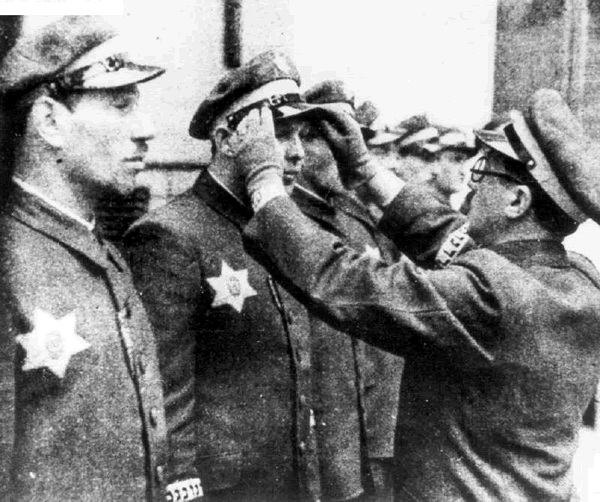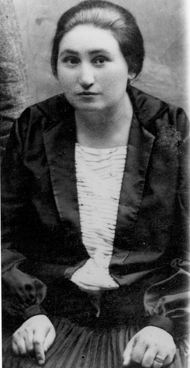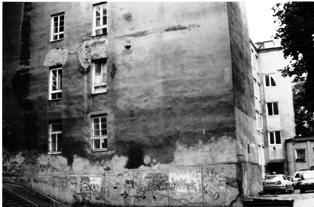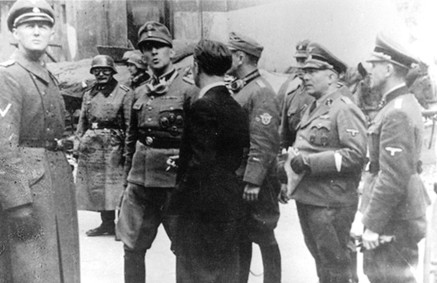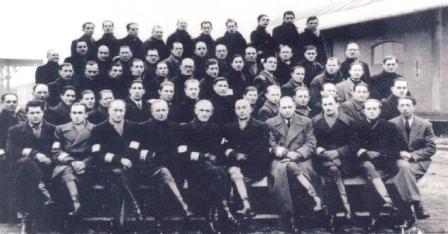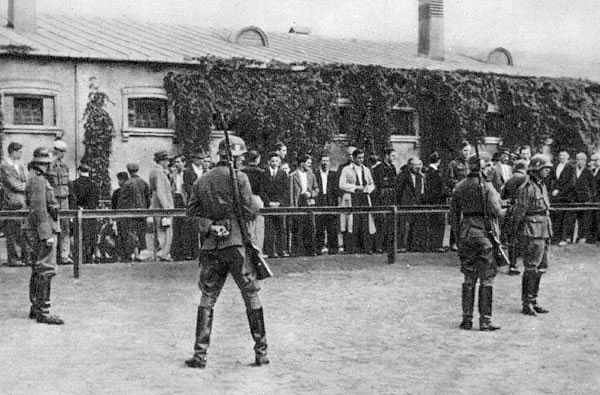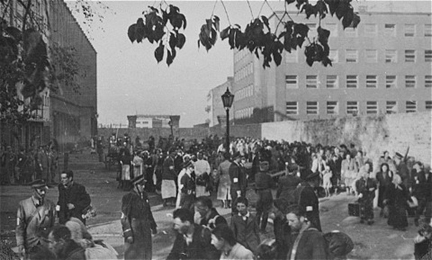Holocaust Education & Archive Research Team |
|
Survivor Stories
Holocaust Survivors Chelmno Survivors Righteous Gentiles Holocaust Recalled
| |||||
Ber Warm
Memoirs of a Jewish Order Service Policeman
Ber Warm was a member of the Jewish Police Force in the Warsaw Ghetto. He was assigned to the Befehlstelle, the SS command post for the deportation and later to the Werterfassungstelle, the Office for Value Assessment. In April 1943 Warm went into hiding on the Aryan side, where he wrote his memoirs, shortly before his death.
I don’t know what went on in the Befehlstelle during the Aktion from the end of July to the middle of August 1942; people just said that Germans were living in the building. I was assigned there as part of the Jewish Sluzba Porzadkowa (SP) in early October 1942, so I know the Befehlstelle as it was between the first large operation and the second in January 1943.
I presume that was when the building located at Zelazna 103 began living up to its name Befehlstelle – command post – for the SS inside the ghetto, since the earlier deportations had been directed from the KSP building at Ogrodowa 17. After this building was excluded from the ghetto at the end of September, the SS headquarters were moved to Zelazna 103.The KSP was permitted to stay on Ogrodowa a little longer, although the Jews had been cleared out from that street during the latter half of August.
The SS, or rather, the SD (Sicherheitsdienst) located at Szucha 23 , had assumed command of the ghetto at the very beginning of the “deportation operation” – that is, at 8 a.m. on 22 July 1942. Until then the ghetto had been administered by civilian authorities, in the person of Commissar Auerswald, plenipotentiary of the Governor of the Warsaw District, who implemented his policies through the President of the Jewish Council. The SS command post inside the ghetto was set up expressly for the Aktion.
SS- Oberscharfuhrer Mende, the representative of Szucha Avenue, administered the first stage of the Aktion from the offices of SP Chief Colonel Szerynski, on the second floor of the SP headquarters at Ogrodowa 17; a plate affixed to the door read Sonderkommando der Sicherheitspolizei Umseidlung (Special Forces of the Security Police Resettlement). The adjacent office was shared by the brothers Stanislaw and Jerzy Czaplinski, district chiefs of the SP; group leader Mayzler; the daytime telephone operator; and Officer Landau, the night operator. The wife of SP sub-district commander Kornheim worked there as a steno- typist.
The delegates from Szucha Avenue and from Einsatz Reinhard chose the KSP building precisely because it served as the assembly point for the SP, which had been ordered to take an active part in the operation by assisting in the forced removal of people to the Umschlagplatz. The locale was probably chosen to facilitate contact with the SP leadership, as well as the rank and file, and to save time between the issuing of orders and their execution.
During the operation, Oberschafuhrer Mende was evidently acting only as a delegate of Szucha Avenue, while others represented Einsatz Reinhard, headquartered in Lublin. Because that office had only sent four or five officials, the deportation authorities had assigned certain local SD men to the Sonderkommando to share administrative duties.
The Befehlstelle had already assumed its final form by the time it moved, together with those Jews who, during the operation, had worked for individual Germans or else for the Sonderkommando in general. The new offices at Zelazna 103 were located at the end of the street, facing the cul-de-sac near the corner of Nowolipie. The three-story structure was recently built and considered contemporary; from the outside it looked quite attractive. The entrance way was paved, with tiled walls. Immediately to the right was a guardroom manned by Junacy – uniformed Poles in German service with a left armband saying Sonderdienst (Special Service). This room was equipped with a small table, an armchair, three sofa beds, and a radio.
Next door was the barber’s room, containing one small table, two armchairs and a medium –sized mirror; a white smocked barber was permanently on call. Following the main corridor, the next room on the right was the Befehlstelle office, which housed the Czaplinski brothers, Mayzler, the SP section chief Mauer, the quartermaster, and pani Kornheim , the steno-typist. This office was equipped with a large table, a desk, a small table, and wall maps of the former and current ghetto, as well as some nondescript pictures.
On the left side of the corridor, opposite the guardroom, were the rickshaw drivers and a shoeshine stand; the room had a small table and chair, as well as a sofa bed.. Farther along was the SP guardroom, with a small table and chair, two sofa beds, and a small locker. At the end of the corridor was a glass door with the same plate I had seen in the KSP: Sonderkommando der Sicherheitspolizei Umseidlung.
On the first door along the left inside this corridor was a sign saying Mende, SS – Oberscharfuhrer. This room had a desk, two armchairs, a closed set of shelves, a chair that folded out into a bed, a trunk on the floor, a radio set, two telephones with special hook-ups, a chandelier with five lamps, maps of the old and new ghettos, and portraits of Hitler and Himmler, as well as some non-descript pictures.
The next two rooms on the left had no signs; I don’t know what they were used for, just as I don’t know the purpose of the three rooms on the right, of which only the middle had a nameplate saying Klaustermeyer – SS Oberscharfuhrer; Becker - SS Oberscharfuhrer. I presume that the unmarked rooms belonged to Obersturmfuhrer Witossek, Untersturmfuhrer Brandt, Unterscharfuhrer Miretschko and SS men Blosche and Ruhrenschopf.
Mende was the permanent on-duty officer at the Befehlstelle. Tall, heavyset with a friendly face, he gave the impression of someone who had never harmed a soul in his life. He arrived by car – the well known black limousine with the licence plate POL 47525 – at exactly eight every morning and left between four and six in the afternoon. Only on occasion would he stay late to work at night. Brandt came every day for several hours, usually in the afternoon and often in the same limousine, which would leave after bringing Mende. More often, however, Brandt drove his own car, a small green Opel with a licence plate that said OST. Witossek also arrived in the black limousine, and they would all leave together.
Brandt had been the desk officer for Jewish affairs at Szucha Avenue before the deportation operation, and it was he who actually oversaw the “Aktion” in the field; after it was over he stayed on as chief spokesman for Jewish affairs, as well as director of the Befehlstelle. Mende was merely the permanent on-duty officer. Witossek supervised operations from the office of Oberpolizei – fuhrer Sammern. He brought orders, evaluated reports, and decided on the more important matters. He frequently came with the Oberfuhrer himself. Brandt was an overweight man of medium height, about forty-five years of age, with an extremely unpleasant face, always scowling, and permanent bulging folds under his eyes. Both he and Witossek had right eyes smaller than their left, or at least they both kept their right eyes in a permanent squint, as if straining to see something.
Witossek resembled Brandt, but his face was smaller and paler, with regular features. I once caught sight of Witossek feeding the geese and chickens that wandered around the courtyard of the Befehlstelle. He had no cap; his head was completely bald; it was hot and he was sweating, but he was enjoying himself and giggling. A few minutes earlier he had decided that three Jews should be shot; that evening they were taken from the Befehlstelle and shot on Smocza Street. These were two smugglers accused of slaughtering a horse and a Befehlstelle rickshaw driver.
The driver had been turning off Leszno Street when he was stopped by a gendarme, who discovered the man was carrying 1,200 zloty. The driver replied haughtily that as an employee of the Befehlstelle, he was allowed to possess such a sum. Brandt’s subordinate Ruhrenschopf, together with the commander of the Sonderdienst unit, shot the driver three times, twice in the head and once in the back. Afterwards the SS man shone his lantern and confirmed that the driver was dead. In fact, none of the bullets was lethal; all three made a clean pass – the first through his mouth, the second through his neck and the third near his collarbone. A work squad coming back down Smocza Street several minutes later found him and took him to hospital. I saw him there; he had grown a beard as a disguise. He recovered after three weeks.
Immediately before the first “Aktion,” Colonel Szerynski had been imprisoned in Pawiak and accused of collaborating with Lieutenant Michalski of the Polish Police to store fur coats, despite the order requiring all furs to be surrounded to the German authorities. Apparently there was quite a large cache, since Szerynski, like Czerniakow had been allowed to keep and wear his own fur coat even after all other Jews were forced to give theirs up.
Rumour had it that Szerynski had Brandt to thank for his sudden release from Pawiak on the first day of the operation, as well as for his return to favour as chief of the SP and especially for his additional appointment as plenipotentiary for resettlement. On the second floor of the police barracks at 10 Nowolipki Street, at the entrance to Szerynski’s apartment, was a sign that read Szerynski Jozef, Der Bevollmachtigte Der Beauftragten Fur Die Umseidlung – Plenipotentiary for the Resettlement Executives.
Whenever Brandt was expected at the Befehlstelle, there was always a flurry of activity, an urge to put things in order, even though everything was always spotlessly clean and in perfect order anyway. Brandt’s first order of business at the Befehlstelle was to get a shave; the barber must have been a good one, though I don’t remember his name. I only know that before the Aktion he was co-owner of a barber shop at Leszno 60. He still made some money from that shop even though he didn’t work there himself – after all, he was now barber to the highest authorities in the ghetto.
After his shave Brandt would call the shoeshine boy, Ajzyk, who would be waiting with his box in the hall, ready to be summoned. Ajzyk, to whom I’ll return later, cleaned Brandt’s shoes with particular care. At the Befehlstelle, Brandt often received visits from the well-known Zionist and literary figure, Professor Alfred Nossig, a German Jew said to have been an Austrian diplomatic representative during the First World War.
About two weeks before the ghetto was liquidated, members of the ZOB shot Nossig in his own home, which suggests that he was a kapus, or stool pigeon, providing Brandt with information from the ghetto. I just learned from reliable sources that, after Nossig was shot, a search uncovered a document that guaranteed his immunity as a Jew of proven merit, as well as a letter he had written to the authorities explaining that the Jews were organising underground bunkers and other things in the event of a new deportation Aktion. The letter gave the locations of some of these shelters and described how they were equipped.
I myself witnessed how cordially Brandt greeted Professor Nossig at the Befehlstelle and how they conversed at some length in the waiting room (this was the barber’s room after the latter was moved to the second floor). Nossig possessed the so-called Brandt pass, which enabled him to move about the whole of the big ghetto, giving him unlimited access to all the factory shops. Upon learning that Nossig had been shot, Bandt is said to have declared, “Ja, die Lumpen haben solch einen alten Mann nicht verschont,” – So, the scoundrels didn’t even spare an old man like him.
How hypocritical that sounded coming from Brandt, a monster in human form who had on his conscience hundreds of thousands of Jews of both sexes and all ages! If Brandt was present, it usually meant there were interrogations going on in Mende’s office. These were mostly of Poles who had been arrested – for trespassing or attempting to trespass the ghetto without a valid pass from the Transferstelle, for attempting to smuggle contraband either over the walls or through the checkpoints, or for looting.
Jews were also interrogated after being brought in by SS men, gendarmes or Junacy for smuggling, trading, slaughtering animals, loitering during working hours, shirking duties, and a host of other offences. But the majority of the cases involved Aryans arrested in connection with looting – which meant taking whatever they could from homes that had been inhabited by Jews.
Occasionally, Czaplinski or Mayzler (both of the SP) were on hand to update the “criminal record” and take confessions, and one of Brandt’s immediate subordinates – such as Ruhrenschopf or Blosche – was always available to function as torturer, though sometimes one of the Junacy filled in.
The reason there were relatively few cases involving Jews at the Befehlstelle was that Herren Klaustermeyer, Miretschko, Becker, and especially Blosche and Ruhrenschopf tended to sentence Jews summarily by shooting them on the spot. They only brought Jews in if they needed to extract further confessions.
The punishments meted out at the Befehlstelle varied. For Poles they ranged from an official reprimand and entry on the record, to flogging, transfer to the Arbeitsamt on Skaryszewska Street, deportation to a penal labour camp, or else the firing squad. Jews who were not released were either flogged – this was rare – transferred to the Umschlagplatz – if it was operating – or else shot – this was most often the case.
Poles were shot in the courtyard of the Befehlstelle; the Jewish undertaker service hauled the corpses to the Jewish cemetery and buried them there. Jews, on the other hand, were generally taken outside, before dusk, most often to Smocza Street, which was by then uninhabited. I know of only one case in which Jews were shot in the Befehlstelle courtyard. This involved the three Bucze brothers, who owned several horse-drawn carts used by the Provisions Department for transporting food to the Umschlagplatz. One time their horse collapsed, and SA Untersurmfuhrer Kerstenberg, the Transferstelle officer at the Umschlagplatz, accused the brothers of attempting to sabotage the operation by under-feeding their horse and sent them to the Befehlstelle. All three were sentenced to death.
The sentences were carried out by one of Brandt’s subordinates, assisted by a guard from the Junacy. Oberscharfuhrer Mende did not participate himself. That SS man in white gloves never beat or shot anyone. Oberscharfuhrer Klaustermeyer also tended not to shoot people on the spot; he preferred to maintain a certain appearance. Klaustermeyer often stood in for Oberscharfuhrer Orf or Oberscharfuhrer Einert at the Leszno checkpoint; if he arrested anyone he would send them to the Befehlstelle, whereas Orf and Einert shot 90 percent of the Jews they detained right then and there. Klaustermeyer also beat the Jews less and the Poles more.
There was little difference between Orf and Einert; they seemed to come from the same school. Orf, if he was drunk, would outdo even himself; he’d shoot for any reason at all – say, for smuggling a quarter kilogram of butter – or beat his victims unconscious. But when it came to beating , neither Orf nor Einert could compare with Scharfuhrer Bogudt, a rather Semitic- looking SS man who was a master with the whip. He represented the Befehlstelle at the Nalewki checkpoint. Trying to smuggle anything past him was out of the question. If he detected the slightest offence, he would beat the person unconscious and permanently cripple him by poking out an eye, fracturing his skull, breaking ribs, and so on. For all that he never shot anyone.
Sometime after the first Aktion, the SS posts were removed from the checkpoints. Orf, Einert and Bogudt went back to Szucha Avenue and never had anything more to do with the ghetto, although Orf would show up now and then to visit his star pupil, SP group officer Jozef Spira. This man had Orf to thank for being permanently assigned to the Leszno checkpoint, along with Einert’s star pupil, SP group officer Klumb.
Despite the potentially lucrative assignment, Spira was not a grajek – someone who specialised in smuggling goods past the guard post. Orf would come in to join Spira for bouts of drinking that lasted well into the night. Spira reported that Orf was a barber by profession, who proved himself sufficiently to win an important job as desk officer for foreign citizens, and he was mainly delegated to special cases of great importance. Indeed at times when Brandt was absent, Orf oversaw the deportations in the field, despite the presence of other SS men of higher rank (such as Oberscharfuhrer Diehm from Lublin and the local Oberscharfuhrer’s Klaustermeyer, Becker and Goescher). Orf at that time was only a Scharfuhrer, he had apparently been demoted for running a motorcycle into a military car while on a drunken joyride.
I saw Orf once last March, when I happened to be standing at the Nalewki checkpoint. It was immediately after a Polish Underground attack on an SS car on Dluga Street. The Germans retaliated by sending all the Poles living in the adjacent buildings to Pawiak. I saw the police cars passing by, each with prisoners and guarded by SS men and German gendarmes, five or six for each car. One of them – a truck loaded with about forty people – was escorted solely by Orf. Unlike the other German, he wasn’t holding his weapon ready; he had shouldered his rifle, as if for a march and his head was bare. He had ordered the people in the truck to kneel and keep their hands folded behind their necks.
Evidently the commanders at Szucha Avenue knew their men and what they were worth. For instance, Oberscharfuhrer Goescher, who was phlegmatic and indecisive and only carried his whip for the sake of form, could never have taken Orf’s place. Once Goescher spent seven days on duty at the Leszno checkpoint, and I never saw him whip anyone; the one time he wanted to send a worker to the Befehlstelle for possessing too much lard, I was able to get him to change his mind. I explained that the man was poor, he had to work hard all day long and smuggling was his family’s means of support. But perhaps Goescher knew that the fate of every Jew had already been decided.
Blosche and Ruhrenschopf struck terror wherever there were Jews, not just inside the ghetto proper but also at the factories. No sooner would they appear than the streets – which by day were pretty deserted anyway – would empty completely. If a street was already dead, it meant the “snipers” were out hunting. Ruhrenschopf typically carried his revolver un-holstered in his pocket.
Later, however, just before the final liquidation of the ghetto, the ZOB carried out more and more executions of informers, and both Blosche and Ruhrenschopf left the sidewalks for the streets, which they would patrol on bicycle, guns in hand. Afraid of losing their own skin, they avoided chasing any Jews into the buildings. Supposedly, they once ran away from a Jew who was defending himself with a knife. It seems they had gone into a basement at Franciszkanska 22, where some cows were being slaughtered. The Germans shot one of the two butchers present, but the other charged at them, wielding his knife. The SS men managed to escape, but they returned a few hours later with a cart, accompanied by two Junacy, ostensibly to confiscate the meat and take it to the Befehlstelle. At the entrance they ordered the Junacy to go in first, but by then the butchers had disappeared.
Hauptsturmfuhrer Michalsen of the Lublin SS was a frequent guest at the Befehlstelle. He oversaw the operations in the Warsaw ghetto on behalf of Einsatz Reinhard, as the delegate of the SS police commandant in Lublin, the notorious monster Globocnik.
During the first Aktion, it was Michalsen who decided what size quotas should be granted to specific workshops and to the Jewish Council – particularly during the final phase of the operation, that is, on 6 September, when all Jews were forced into the so-called cauldron between Gesia and Niska streets. Throughout the first Aktion, Michalsen stayed in Warsaw off and on, occasionally leaving for a day or two. People linked his departure with the end of the Aktion, but this hypothesis proved wrong: Both the second and last operations began before he actually returned to Warsaw- to participate as murderer –in-chief.
From January 1943 on, a detachment of Gendarmes was stationed at the Befehlstelle, partly to increase the German police presence within the ghetto and partly to deter Poles from looting. Large numbers of Poles, mostly Aryan teenagers, would sneak inside the ghetto any way they could and break into apartments formerly inhabited by Jews. There they would take whatever had been left behind: clothing, pots, brushes, washbasins, clothes wringers, window frames and even furniture, which they would pass back across the ghetto wall.
Boys fourteen years or younger would be locked up at the Befehlstelle for a few days, flogged and released. Older offenders received the usual punishment. Floggings ranged from five to fifty lashes to the naked body; repeat offenders received more than first-time delinquents. I once met some boys who bragged that they had been sent to the Befehlstelle eight times: “And as soon as it stops hurting we’ll be back.”
A Junacy (Sonderdienst) unit guarded the Befehlstelle throughout the entire year of its existence, operating in two 24-hour shifts, from 1300 to 1300, with five men per shift. These men manned the entry post there as well as the jail (until the latter function was taken over by the Jewish SP). In addition, the Junacy escorted goods confiscated at the checkpoints to the Werterfassung (the collecting point for former Jewish property) at 20 Niska Street.
They also escorted Poles to the Arbeitsamt on Skaryszewska Street, and Jews to the President of the Jewish Council or to the Umschlagplatz, which between deportations became a Durchgangslager, or temporary transit camp for labourers. Frequently the Junacy administered floggings under SS supervision; they also assisted directly or indirectly with firing squads. Rarely did they help torture prisoners under interrogation. Generally speaking, the Junacy faithfully followed SS orders; there were isolated instances when they would attempt to help someone, though only for material reward.
Sources:
Words to Outlive Us, edited by Michal Grynberg published by Granta Publications 2003 A Child at Gunpoint by Richard Raskin, published by Aarhus University Press 2004 Ghetto Fighters House Holocaust Historical Society The Survival of Love – Jozef Garlinski The Warsaw Ghetto – A Photographic Record 1941-44 – Joe J Heydecker
Copyright Lukasz Zdunski H.E.A.R.T 2012
|
